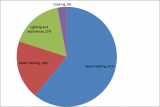The way we use electricity in our rural homes, and the opportunities for change, are important considerations for how we to transition to low carbon living. Unlike heat and transport, there are few significant differences between urban and rural dwellers in the type and way we use our electricity, but it is useful to consider rural household demand for, and use of, electricity and how this will change with greater electrification in the move to a low carbon society. This post, therefore, focuses on electricity, the final of the three modes of energy use (and so emissions) associated with rural living.
As noted, energy use can be split into three modes: heat (in the built environment); transport; and electricity. Previous posts in this series have provided an overview (for example here and here) of some of the issues for rural people in the Western Region in their transition to a low carbon society. I have also covered heat in our homes and energy efficiency and retrofit , and transport, why we travel and what we know about travel in the Western Region. As we are looking at rural dwellers, rather than the broader rural economy which would include agriculture and enterprise, the focus of this WDC work is on the way we use energy, in its different modes, as part of our daily lives.
While patterns of electricity use may not differ significantly between urban and rural areas, there are differences in relation to the supply of electricity in terms of generation, distribution and transmission which all have significant rural impacts and opportunities. These will be discussed in a future post on this topic.
Electricity use in the home
In 2018 the residential sector accounted for 30.1% of final electricity consumption, similar to that in 2005 (30.8%), with the significant difference that, in 2005, 7.2% of the electricity consumed came from renewable sources, while in 2018 it was 33.2%[1]. It is targeted to be 70% by 2030.
There is little specific information about rural electricity demand and patterns of consumption, so before considering some of the potential difference between urban and rural households, it is useful to look at what we do know about household electricity consumption. In 2018, SEAI published Energy in the Residential Sector which gives details data for energy use in the home in 2016.
This shows that electricity accounted for 25% of Irish household final energy usage 2016 (compared to 37% from oil and 21% from gas. Most of this energy was used in heating (as shown in Figure 1) and oil and gas are the dominant fuels for this (as was considered in a previous post). The focus of this post is on electricity use in relation to appliances and cooking (20%). Water heating is generally considered along with space heating as much of it can be done by the central heating system.

Figure 1: Energy use in an average Irish home, 2016
SEAI, 2018, Energy in the Residential Sector
Between 2007 and 2014 final energy use of electricity per dwelling reduced by 16% having increased by 31% between 1990 and 2007 but more recent data[2] show an increase in residential electricity consumption between 2016 and 2018[3].
The CRU provides a figure of 4,200 kWh electricity usage per year as an average for all households. Moneyguide Ireland estimates typical annual usage in kWh could be from 2,100 in a 1-2 bed apartment to 8,000 4-6 bedroom large house. As rural homes tend to be larger and detached consumption is more likely to be at the higher levels.
What are we using electricity for?
The lighting and appliances which account for 17% of energy use in the home are almost all powered by electricity. To understand what will change with a move to a low carbon household it is useful to remind ourselves about the appliances we have.
Data from the CSO Household Budget Survey (Figure 2) shows how common the different appliances were in our homes in 2015-2016.

Figure 2: Percentage of households with select household appliances 2015–2016
Source: CSO Household Budget Survey 2015-2016
Almost all households have a washing machine, a TV and a vacuum cleaner. The box below gives a sense of how we use energy with these appliances with an estimate of how long it takes each appliance to use 1 unit of electricity (1kWh). Each unit currently costs about 20c on average including VAT.
Some calculations for how long it would take for various appliances to use 1 kWh and cost you about 20c
- Using a 10,000 watt electric shower for 6 minutes
- Keeping an immersion heater (3,000 watts) on for 20 minutes
- Cooking in a 2,000 watt oven for 30 minutes
- Ironing with a 1,500 watt iron for 45 minutes
- Less than an hour using a dishwasher (1,000 – 1,500 watts)
- Watching a plasma TV (280 – 450 watts) – about 3 hours
- Keeping a fridge-freezer (200 – 400 watts) on for about about 3 hours
- Keeping an electric blanket (130 – 200 watts) on all night
- Using a laptop (20 – 50 watts) all day
- Keep a 5 watt LED lightbulb on for 200 hours
Source: Moneyguide Ireland
Over time the energy efficiency of our household appliances is improving (see here for discussion) which in turn should contribute to reducing energy consumption in our homes. Lighting, in particular, has seen very significant increases in efficiency with the move away from incandescent bulbs, and new tumble dryers with heat pumps are much more efficient (though also more expensive to purchase). However at the same time, if the number of appliances continues to increase, for example more televisions, more tumble dryers or more dishwashers, overall household consumption from appliances could increase.
Differences in rural and urban electric consumption.
There is little data on differences in rural and urban electricity consumption but in 2013 (the most data[4]) 31 % of customers (634,306) were classified as ‘rural domestic’ (and so pay the higher rural standing charge[5]) but rural domestic customers accounted for 34% of domestic use (2,908 GWh).
The definition of ‘rural domestic’ is assigned by ESB Networks and so there will be people living in rural areas classified as ‘urban’ customers (especially in small towns and villages), but the classification is important as those rural customers may have different issues in relation to supply, which is discussed more in the next post.
There is little information on the reasons for higher rural electricity demand (though it is something that should be explored further in future) but there are a number of likely reasons. As seen before rural homes in the Western Region and elsewhere tend to be larger and are more likely to be detached. Larger homes use more energy of all forms will have more lighting and more space for, and demand from, other appliances. In contrast, however, they are less likely than urban homes (apartments in particular) to use electricity as their primary heating source. With most rural homes not connected to the natural gas grid, electricity is more likely to be used for cooking, although bottled gas is also an important cooking fuel in rural areas.
In terms of appliances, again there is little information on the differences between urban and rural households, and such differences are likely to be more related to house size, household size and income, than to urban and rural factors. Rural homes may also have other specific uses of electricity such as for water pumps from private wells, and for certain domestic wastewater treatment systems.
The future
The consideration of electricity demand and appliances here relate to current electricity consumption issues and patterns but of course significant changes in these are expected in the future with the move to greater electrification of heat and transport. As the SEAI notes “Increasing the electrification of thermal and transport loads, much of which can be shiftable and controllable, facilitates much greater quantities of variable supply (e.g. wind / ocean energy)”. Increases in electricity consumption from heating and vehicle charging are, however, likely to be tempered somewhat by increased energy efficiency in electricity use, in appliances and other electrically powered items alongside a reduction in distribution and transmission energy losses.
A significant move to EVs will increase domestic demand. Most EV charging will take place at home, probably overnight (or when electricity is cheap (see below)). Rural homes with off street parking are particularly well suited to this and the lack of other transport options is likely to mean, in the longer term, a higher number of EVs per rural household than urban (as is the case with cars at present). Similarly the longer distances to be travelled will mean higher electricity consumption by rural vehicles.
The electrification of heating (including the targeted increase in the use of heat pumps) with a switch to the use of heat pumps will also increase electricity consumption, though of course it will mean lower overall household energy consumption.
Alongside these changes are likely to be developments in smart appliances and smarter charging allowing for the use of many electricity appliances to be determined by the cost of electricity at a particular time, either because of lower demand on the system (such as at night) or cheaper generation (e.g. windy days). Increasing the electrification of domestic space and hot water heating, and personal transport will increase the use of electricity, but automating use decisions will increase the proportion of renewable electricity consumed in the home. For more discussion of this potential see SEAI’s Smart Grid Roadmap. A more detailed discussion of potential changes in electricity demand and consumption patterns is also available in EirGrid’s Tomorrow’s Energy Scenarios.
To plan for this shift to electrification, changes which may be needed in domestic electricity connections and their capacity are being addressed under Action 174 of the Climate Action Plan. This will involve the introduction, as required, of new urban and rural domestic connection design standards and infrastructure sizing and design standards to reflect the demand of domestic scale low-carbon technologies
Conclusion
As discussed in this post, there is little understanding of differences between urban and rural dwellers in the type and way they use their electricity. It would be important to have more information about rural household demand for, and use of, electricity and how this will change with greater electrification in the move to a low carbon society.
There is significant future potential for electrification of heat and transport in rural areas, but it should also be remembered than many rural dwellers lack the financial resources to switch to low carbon or carbon free alternatives. It is important that we recognise this, alongside understanding rural differences in electricity and other energy use when we are planning for a low carbon rural economy and society.
Helen McHenry
[1] SEAI Energy Statistics 2019 report
[2] SEAI, Energy in Ireland 2019
[3] Data for 2007-2016 has been weather corrected but not for 2016-2018 so these are not completely comparable.
[4] ESB Networks Key Statistics 2014
[5] There is a useful comparison of current rural electricity charges here http://www.moneyguideireland.com/rural-electricity-charges-compared-to-urban.html





